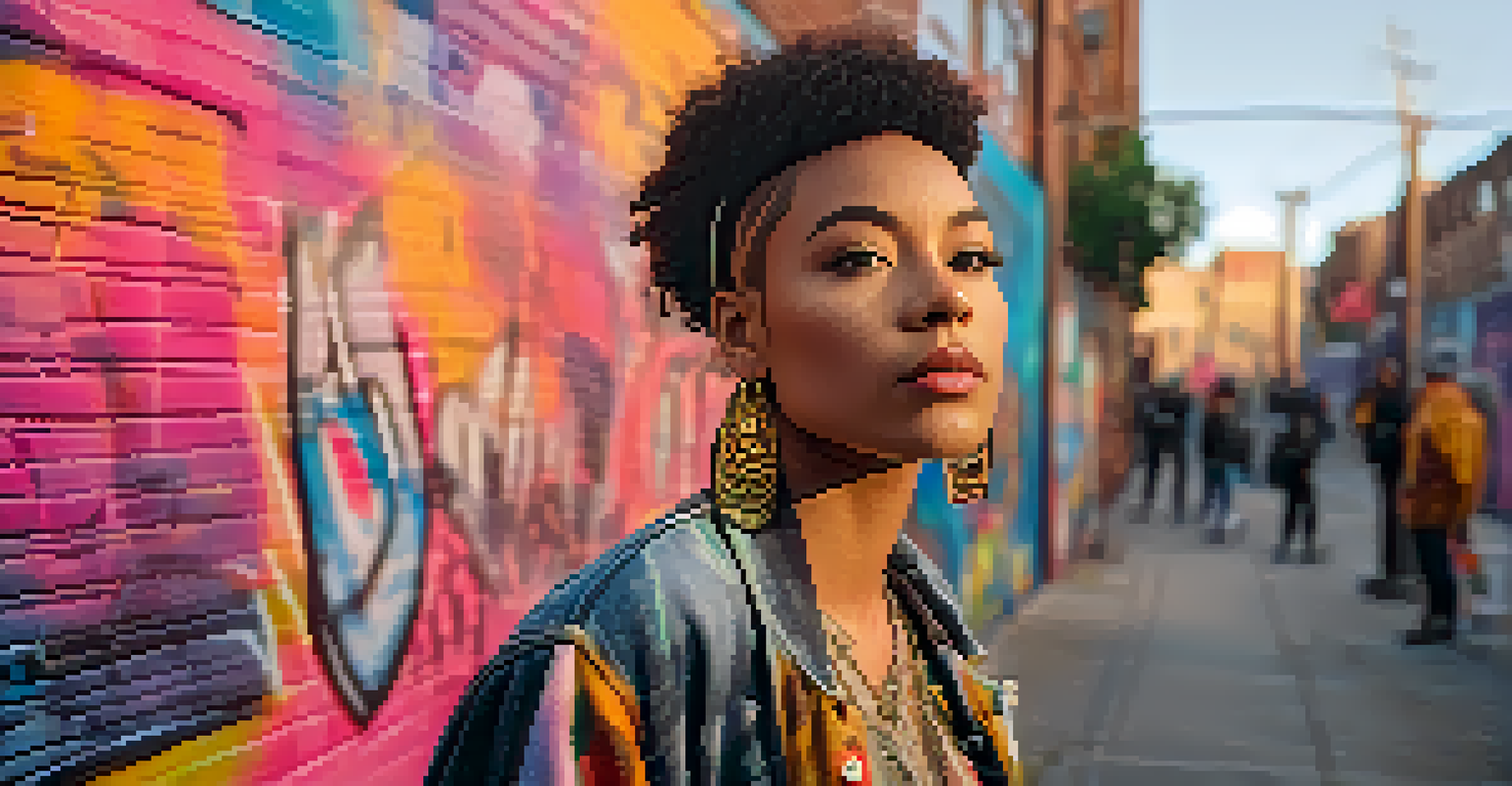Cinematic Portrayals of Trans Identity in Film History

The Early Days: Trans Identity in Silent Films
In the early 20th century, silent films rarely explored trans identity, often relegating such themes to subtext or comedic relief. Characters cross-dressing for humor was a common trope, like in the 1920 film 'The Cabinet of Dr. Caligari,' where gender ambiguity raised eyebrows but lacked depth. These portrayals were simplistic and rarely acknowledged the complexity of trans experiences, reducing them to mere plot devices.
Representation is not just about visibility; it’s about authenticity and depth.
As cinema evolved, so did the representation of gender and sexuality. However, even in talkies, trans individuals were often depicted through a lens of sensationalism. Films like 'Some Like It Hot' introduced cross-dressing in a more mainstream context, yet they still emphasized comedy over authenticity, leaving trans narratives underexplored.
Overall, the silent film era set a precedent that often trivialized trans identities, making it challenging for more nuanced portrayals to emerge in subsequent decades. This lack of authentic representation laid the groundwork for ongoing misconceptions in later films.
The 1970s: A Turning Point for Trans Representation
The 1970s marked a pivotal shift in how trans identities were portrayed in film. Movies like 'The Rocky Horror Picture Show' introduced audiences to flamboyant characters, creating a cultural phenomenon that celebrated gender fluidity. This film was groundbreaking, showcasing the joy and complexity of queer identities, even if it still leaned into stereotypes.

However, not all representations were celebratory. Films like 'Dog Day Afternoon' highlighted the struggles of trans individuals, particularly through the lens of societal acceptance and personal identity. This duality in representation began to shed light on the real-life challenges faced by the trans community, as it resonated with broader social movements.
Trans Representation Evolved Over Time
The portrayal of trans identities in film has shifted from simplistic and comedic depictions in the early days to more nuanced and authentic narratives in recent years.
This era laid important groundwork for future trans narratives, revealing a growing awareness of gender diversity. While progress was made, it also underscored the need for more authentic and compassionate portrayals in the years to come.
The 1990s: Struggles and Stereotypes in Film
The 1990s brought both progress and setbacks for trans representation in film. On one hand, films like 'Paris is Burning' provided a documentary-style glimpse into the lives of trans and gender non-conforming individuals within the ballroom culture. This film offered an authentic portrayal that celebrated their resilience and creativity, showcasing the beauty of queer subculture.
The stories of trans people are as varied and complex as the people themselves.
Conversely, the era also witnessed problematic depictions, as seen in films like 'The Crying Game.' While it sparked conversations about gender identity, it fell into the trap of the 'twist ending' trope, which often marginalized trans experiences in favor of shock value. Such portrayals perpetuated harmful stereotypes and misrepresented the complexity of trans identities.
The dual nature of the 1990s highlighted the ongoing struggle for authentic representation. While some films celebrated trans lives, others reinforced damaging narratives that complicated the fight for acceptance and understanding in mainstream media.
The 2000s: Seeking Authenticity and Visibility
The 2000s marked a significant shift towards more authentic portrayals of trans identities in film. Movies like 'Boys Don't Cry' brought attention to the real-life story of Brandon Teena, offering a raw and emotional exploration of identity and societal rejection. This film was a catalyst for conversations about gender identity, highlighting the violence faced by trans individuals.
This decade also saw the rise of trans actors in prominent roles, contributing to more genuine representation. With films like 'Transamerica,' audiences were introduced to narratives that centered on trans experiences, depicting their journeys with nuance and empathy. These films began to challenge stereotypes and foster a deeper understanding of what it means to be transgender.
Streaming Services Amplify Trans Voices
The rise of streaming platforms has provided a valuable space for diverse and authentic trans stories, challenging stereotypes and fostering greater understanding.
As conversations around gender identity gained traction, the 2000s became a crucial period for visibility. While not without its flaws, the decade's focus on authentic narratives paved the way for more inclusive storytelling in the years to come.
The 2010s: A New Era of Representation
The 2010s heralded a new era of representation for trans individuals, with films like 'The Danish Girl' and 'Tangerine' showcasing diverse experiences. 'Tangerine,' filmed entirely on an iPhone, highlighted the lives of trans women of color, emphasizing the importance of intersectionality in storytelling. This focus on authenticity was a refreshing departure from the stereotypical portrayals of earlier decades.
Moreover, the rise of trans actors in leading roles, such as Laverne Cox in 'Orange is the New Black,' further pushed the boundaries of representation. Their presence allowed for more nuanced narratives and brought attention to the complexities and richness of trans experiences, contributing to a broader cultural shift toward acceptance.
While still facing challenges, the 2010s made significant strides in portraying trans identities with respect and depth. This decade set a strong foundation for continued progress in the years to come, as audiences began to demand more authentic and diverse representations.
The Impact of Streaming Services on Trans Narratives
The rise of streaming services has revolutionized how stories about trans identities are told and shared. Platforms like Netflix and Hulu have provided a space for unique stories, allowing filmmakers to explore diverse narratives that might not have found a home in traditional cinema. This has led to an influx of content that centers trans experiences, reflecting the growing demand for authenticity.
Shows like 'Pose' and 'Disclosure' have not only highlighted the lives of trans individuals but have also celebrated their contributions to art and culture. These productions have garnered critical acclaim and have encouraged audiences to engage with trans narratives in more meaningful ways. Such visibility is crucial in fostering understanding and acceptance.
Future Demands Authentic Storytelling
There is a growing call for filmmakers to create genuine narratives that reflect the complexity of trans experiences, driven by both audience advocacy and industry responsibility.
As streaming services continue to shape the landscape of entertainment, they play a vital role in elevating trans voices and stories. This shift has the potential to further challenge stereotypes and promote a broader understanding of the complexities of gender identity, paving the way for a more inclusive future in film.
Looking Ahead: The Future of Trans Representation in Film
As we look to the future, the representation of trans identities in film holds both promise and responsibility. There is a growing recognition of the need for authentic storytelling that reflects the diverse experiences within the trans community. Filmmakers are increasingly aware that their narratives should be informed by the voices of those they portray, fostering a culture of inclusivity.
Moreover, audiences are becoming more discerning, advocating for representation that goes beyond stereotypes. This shift encourages filmmakers to take risks and explore lesser-told stories, allowing for a more comprehensive understanding of trans experiences. The demand for authenticity is reshaping the industry, creating opportunities for new voices to emerge.

Ultimately, the future of trans representation in film will depend on continued advocacy and support for diverse narratives. By amplifying the voices of trans individuals and sharing their stories with compassion and truth, cinema can play a transformative role in promoting understanding and acceptance in society.